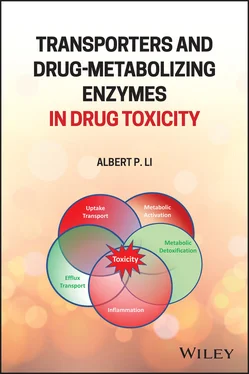While the mechanism of hepatotoxicity for troglitazone has not been fully established, experimental investigations, and correlation studies show that reactive metabolite formation and BSEP inhibition are the most likely mechanism for troglitazone‐induced liver injuries. The potential risk factors are genetic and environmental conditions that would lead to enhanced formation of metabolites (e.g. P450 induction), compromised detoxification pathways (e.g. reduced cellular GSH levels or GST activities), and sensitized cytotoxic inflammatory responses. Null mutations of GSTM1 and GSTT1 have been associated with increases in liver enzymes in troglitazone patients, suggesting the involvement reactive metabolite formation in troglitazone hepatotoxicity [228]. However, a correlation analysis between P450 isoform activities and EC50 with primary human hepatocytes from 27 donors showed that the best correlation was made not with any of the individual isoforms, but with the activity product of CYP3A4 × UGT)/SULT [229], suggesting that troglitazone is directly cytotoxic, with CYP3A4 and UGT as detoxifying and sulfotransferase (SULT) as activating activities. This correlation is consistent with the hypothesis of BSEP inhibition by troglitazone sulfate conjugates, leading to accumulation of intracellular bile salts in hepatocytes, as a key mechanism of hepatotoxicity [230]. Further, experimental evidence exists suggesting that inflammatory events may exacerbate troglitazone hepatotoxicity [231].Troglitazone‐induced liver failures represent an example where occurrence of idiosyncratic liver toxicity is a result of simultaneous occurrence of multiple sensitizing events as stated by Li’s Multiple Determinant Hypothesis [232], with the sensitizing events being enhanced metabolism of reactive metabolites (e.g. induced CYP3A4 activity), compromised GSH conjugation of reactive metabolites (e.g. reduced cellular GSH levels, reduced GST activities), enhanced sulfate formation (e.g. enhanced SULT activity), and sensitized cytotoxic immune response.
Trovafloxacin is a fluoroquinolone (FQ) with broad spectrum antibiotic properties. Trovafloxacin inhibits two key enzymes for bacterial cell replication: (i) DNA gyrase, an essential enzyme that is involved in the replication, transcription, and repair of bacterial DNA; and (ii) Topoisomerase IV, an enzyme known to play a key role in the partitioning of the chromosomal DNA during bacterial cell division [233, 234]. FQ drugs have the potential to be effective toward bacteria that are resistant to commonly used antibiotics (e.g. penicillins, cephalosporins, aminoglycosides, macrolides, and tetracyclines) that have different mechanism of action.
Trovafloxacin was approved by FDA in 1997. In 1999, FDA placed limits on its application due to its association with 140 reports of hepatic events [235–237] and, including 14 cases of hepatic failure, leading to 6 deaths [235].
3.13.1 Metabolism and Toxicity
While the exact mechanism for the hepatotoxic properties of trovafloxacin is not yet fully elucidated, several lines of evidence suggest that enzymatic oxidation of the cyclopropylamine moiety to reactive metabolites is involved. Via synthesizing a drug model of trovafloxacin which contains the cyclopropylamine substructure, Sun et al. showed that chemical oxidants could oxidize the drug model to a reactive alpha, beta‐unsaturated aldehyde [238]. The same laboratory also showed that CYP1A2 and myeloperoxidase could oxidize the drug model to the same reactive aldehyde which could conjugate reduced GSH and form protein adducts [239]. Shaw et al. showed that hepatotoxicity could be induced with a nonhepatotoxic dose of trovafloxacin upon coadministration of nonhepatotoxic doses of lipopolysaccharide (LPS), with significant elevation of TNFa proceeding the onset of liver injuries. Inhibition of TNFa transcription by pentoxifylline or inhibition of TNFa activity by etanercept were found to reduce trovafloxacin/LPS‐induced hepatotoxicity [240–242]. The results suggest that inflammatory insults may exacerbate trovafloxacin hepatotoxicity, with TNFa as a possible mediator for the initiation of the toxic events.
3.13.2 Transporters and Toxicity
While there are no reports on the role of transporters on hepatic uptake and efflux, it has been reported that trovafloxacin could bioaccumulate in cultured human polymorphonuclear leukocytes (PMNs), human peritoneal macrophages, and tissue‐cultured epithelial cells (McCoy cells), albeit in a nonsaturable manner and was enhanced at 4 °C, thereby eliminating the involvement of uptake transporters [243].
The current information suggests that environmental and genetic factors that could enhance the formation of reactive metabolites (e.g. inducers of CYP1A1 and myeloperoxidase), reduction of cellular GSH, and inflammatory insults are likely risk factors for trovafloxacin hepatotoxicity.
A review on the uptake, efflux, and metabolism of the 12 toxic drugs show that drug–drug interactions, metabolic activation, and BSEP inhibition represent the key mechanism of toxicity ( Table 3.1). With our current extensive mechanistic understanding of metabolic enzyme and transporter induction and inhibition, and the resulting effective in vitro / in vivo experimental approaches, toxicity due to drug–drug interactions with prescription drugs can be effectively managed. The next frontier for toxicity resulting from drug‐interactions is health supplements which have not been systematically evaluated for drug interaction potential.
Table 3.1 A summary of the key mechanisms of drug‐induced toxicity for the 12 toxic drugs.
| Drug |
Mechanism of drug‐induced toxicity |
| BSEP inhibition |
Reactive metabolite formation |
Metabolic drug interactions |
| Acetaminophen |
— |
X |
— |
| Cerivastatin |
— |
— |
X |
| Felbamate |
— |
X |
— |
| Flucloxacillin |
— |
X |
— |
| Nefazodone |
— |
X |
— |
| Obeticholic acid |
X |
— |
— |
| Sitaxentan |
— |
X |
— |
| Sorivudine |
— |
— |
X |
| Tacrine |
— |
X |
— |
| Terfenadine |
— |
— |
X |
| Troglitazone |
X |
X |
— |
| Trovafloxacin |
— |
X |
— |
Toxicity affected by metabolic activation and detoxification remains challenging. The analysis of potential risk factors suggests that toxicity may be enhanced as a result of genetic and environmental factors that would lead to co‐occurrence of multiple events: (i) Increased body burden of the toxic drug due to enhanced absorption resulting from enhanced enteric uptake transport and/or decreased effux transport. (ii) Increased liver burden resulting from enhanced hepatic uptake transport and/or decreased efflux transport. (iii) Elevated toxic parent drug/metabolites due to enhanced metabolic activation and decreased metabolic detoxification. Severe drug toxicity resulting from the co‐occurrence of these multiple risk enhancing factors is the basis for the Multiple Determinant Hypothesis of idiosyncratic drug toxicity.
1 1 Honig S, Murray KA. Postsurgical pain: zomepirac sodium, propoxyphene/‐acetaminophen combination, and placebo. J Clin Pharmacol 1981; 21 (10):443–8.
2 2 Pircio AW, Buyniski JP, Roebel LE. Pharmacological effects of a combination of butorphanol and acetaminophen. Arch Int Pharmacodyn Ther 1978; 235(1):116–23.
Читать дальше












